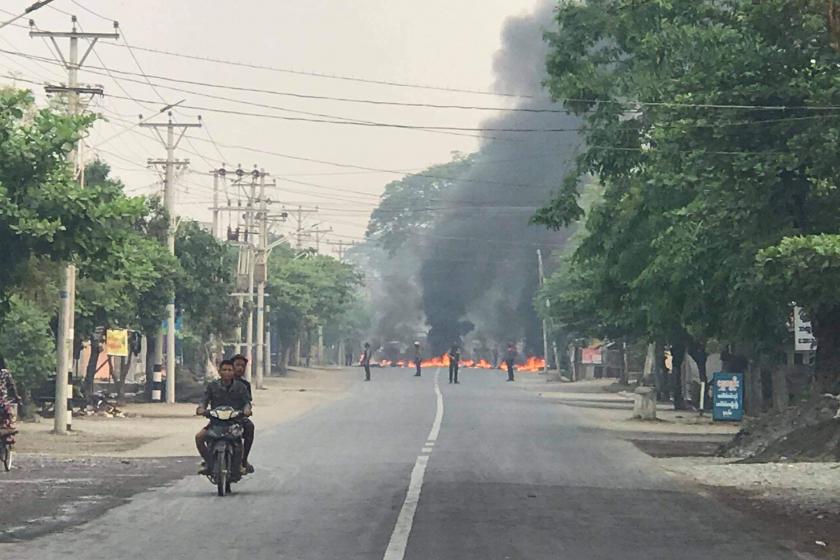
Regime forces killed at least 20 people in Sagaing and Bago regions on Wednesday, pushing the death toll from two months of crackdowns on anti-coup protests past a new threshold.
Added to figures compiled by the Assistance Association for Political Prisoners, the latest deaths confirmed by Myanmar Now late Wednesday night bring the total number of civilians killed by the regime since it seized power on February 1 to 606.
Most of the fatalities reported on Wednesday were in the Sagaing region town of Kalay, where local medical teams confirmed that a day-long crackdown on the town’s Tahan protest camp had left at least 11 people dead.
This figure is up from eight reported dead earlier in the day and is expected to continue to rise.
“They were shooting at every shadow, positioning themselves on every corner and every street that led to the protest camp,” a Kalay resident said of the junta’s armed forces.
“They were hiding in ditches and lying in ambush,” he added, noting that non-protesters were likely among those killed.
Local media reported that three of the 11 people killed were not involved in protest activities.
An unknown number of arrests were also made. Photos circulating on social media show several people with their eyes blindfolded and their hands tied behind their backs in the custody of soldiers.
Meanwhile, in another part of Sagaing, seven men were shot dead by regime forces in the town of Taze on Wednesday afternoon, according to a member of a local relief group who spoke to Myanmar Now.
The relief worker said he was unable to provide further details about the situation in the town because his team was still trying to rescue wounded people from the protest site at the time of reporting.
A Taze local said that three of those killed were in their 30s.
According to local sources, it was the first time that the town’s anti-coup rallies, which routinely attracted tens of thousands of protesters, had come under attack by junta forces.

The sources said that around 100 troops arrived in the town in six military vehicles earlier in the day to carry out the crackdown.
“At the entrance to Taze, people used sandbags to block three military trucks coming from Ye-U township. Then the fighting broke out,” a resident of the town told Myanmar Now.
Another local said the junta’s armed forces had a variety of weapons at their disposal, including sniper rifles, while the town’s residents were armed only with homemade guns.
At least 20 people, including a monk, were injured in the clash, he said.
There were also two reported deaths in Bago, where armed troops entered the city’s Kyauk Gyi Su ward and opened fire in a residential neighbourhood, according to local sources.
The two victims were identified as 20-year-old Chan Myae and 48-year-old A Nge Lay, both of whom were shot in the head. The latter individual’s body has not been retrieved.
Meanwhile, a series of small blasts was reported in Yangon on Wednesday, while a Chinese-owned factory was set on fire in the city’s western industrial outskirts.
The blasts occurred at seven locations around the city, including near government offices and a military compound, and caused only minor damage. No injuries were reported.

The fire at the JOC Galaxy (Myanmar) Apparel factory in Hlaing Tharyar township started at around 5:35am and was put out by 6:55am, the township’s fire department reported. No details about the extent of the damage from the blaze were released.
The fire and the blasts came as the regime claimed on state TV on Wednesday that a suspect had been arrested in connection with an incident that took place outside the US embassy’s American Centre on March 27.
The regime alleged that Aye Thaw Kaung, a member of the family that owns the famous Shwe Puzun bakery in Yangon, had purchased a high-pressure air gun online for 190,000 kyat and used it to fire lead balls at the centre in order to “create political complications” in relations between the United States and Myanmar.
Aye Thaw Kaung was also identified as a supporter of the National League for Democracy, the party of ousted civilian leader Aung San Suu Kyi, who has been detained since the military seized power.
Pro-democracy demonstrations have taken place around the country almost continuously since the coup, resulting in a steady escalation of violence by the regime in an effort to crush popular resistance to its rule.
On Tuesday, the Committee Representing the Pyidaungsu Hluttaw (CRPH), a body consisting of lawmakers from the ousted civilian government, released a statement claiming that it had collected 180,000 pieces of evidence that show “wide-scale abuses of human rights” by the military.
The CRPH said it has directed its international legal counsel at the Volterra Fietta law firm to communicate with different international human rights bodies of the United Nations to share evidence of the Myanmar regime’s crimes.



